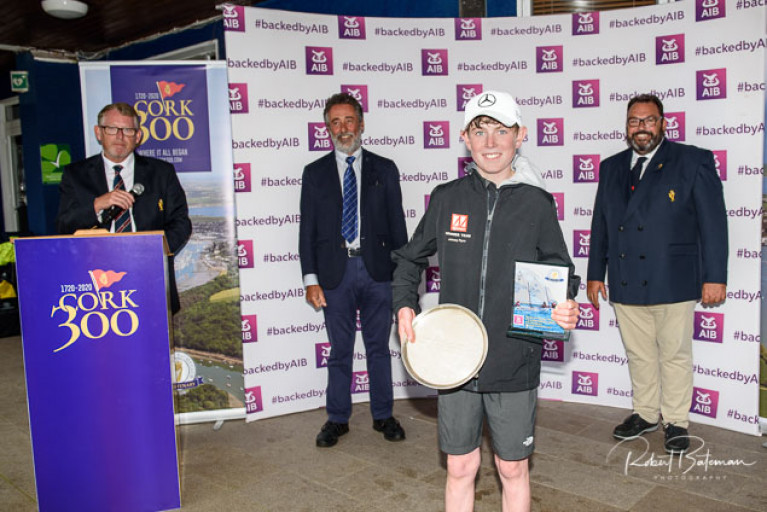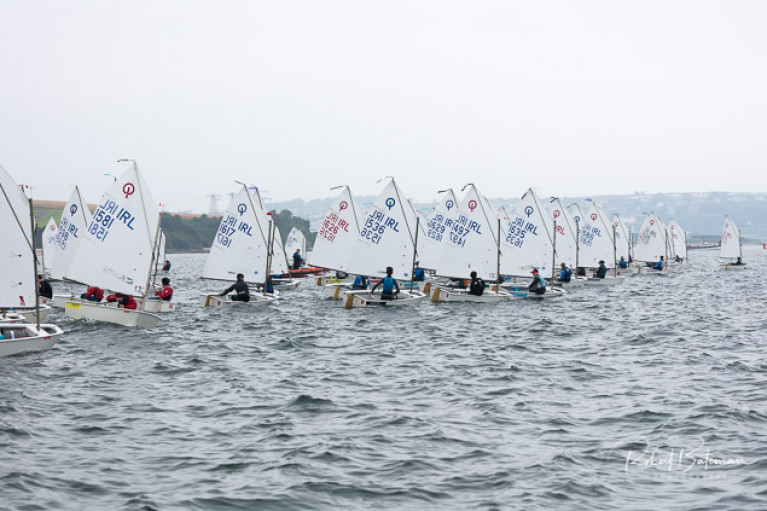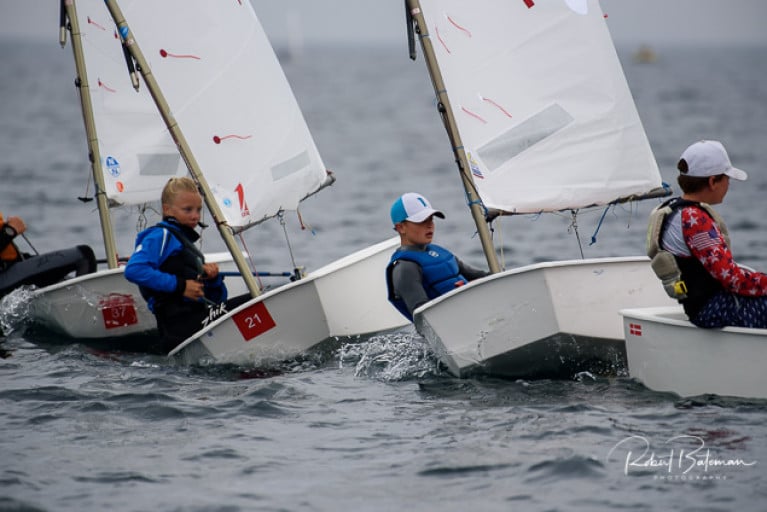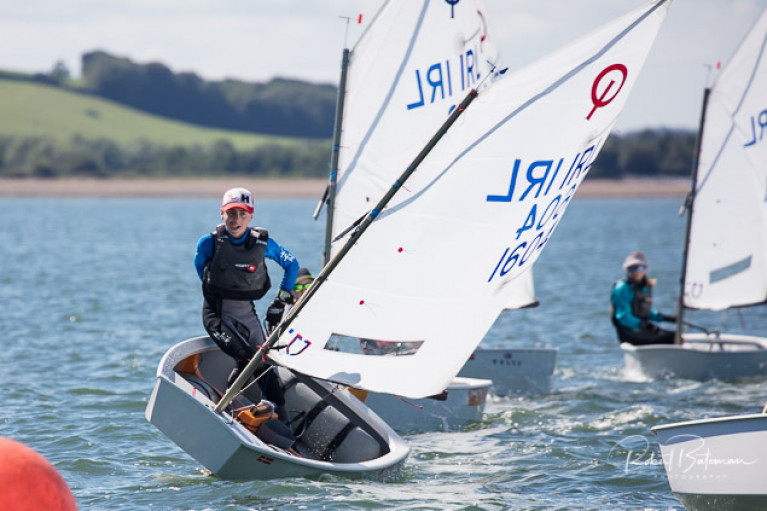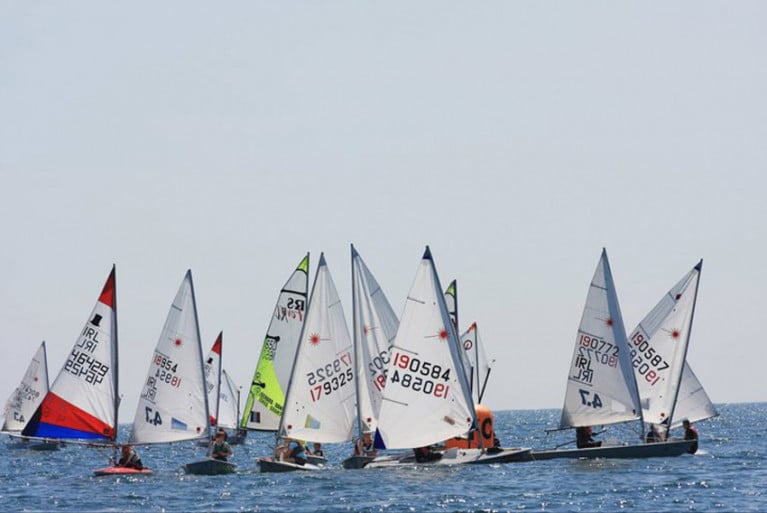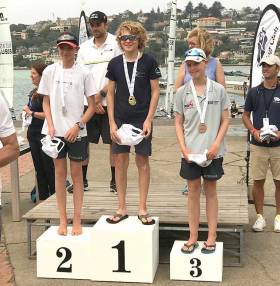Displaying items by tag: Optimist
Howth Yacht Club teen Johnny Flynn overtook local ace and regatta leader Ben O'Shaughnessy to clinch the AIB sponsored Optimist Nationals by a single point at Royal Cork Yacht Club today.
After four days of racing on the Curlane Bank and outside Cork Harbour, the Dubliner finished the ten-race light-air event on a tally of 16 points to the Crosshaven boy's 17.
Anthony O’Leary was the Race Officer for the Main Fleet and Barry Rose officiated for the Regatta Fleet.
 Second overall - Ben O'Shaughnessy of Royal Cork Yacht Club Photo: Bateman
Second overall - Ben O'Shaughnessy of Royal Cork Yacht Club Photo: Bateman
 Third overall Rocco Wright of Howth Yacht Club Photo: Bateman
Third overall Rocco Wright of Howth Yacht Club Photo: Bateman
Flynn's club mate, 14-year-old Rocco Wright, finished in third on 30-points in the 79-boat main fleet.
The National Yacht Club's Clementine van Steenberge was the first girl in fifth overall.
 The National Yacht Club's Clementine van Steenberge was the top girl in fifth overall Photo: Bob Bateman
The National Yacht Club's Clementine van Steenberge was the top girl in fifth overall Photo: Bob Bateman
The fight for gold in the 36-boat Junior Championships came down to who beat who in the final race and the NYC's Caoilinn Geraghty-McDonnell beat Des Turvey of Howth with Riona McMorrow Moriarty in third.
 Junior National Champion is Caoilinn Geraghty-McDonnell of NYC
Junior National Champion is Caoilinn Geraghty-McDonnell of NYC
A 34-boat Regatta fleet was won by RCYC's Ethel Bateman who beat her brother Olin. Third place went to Henrietta Leech from Lough Ree Yacht Club.
 Regatta champion Ethel Bateman of Royal Cork
Regatta champion Ethel Bateman of Royal Cork
Prizes were presented by Royal Cork Admiral Colin Morehead, event organiser Brian Jones and IODAI President Tim Lucas.
Overall results are here
Bob Bateman's 2020 Optimist Championship Prizegiving slideshow below
Royal Cork's Ben O'Shaughnessy Continues to Lead Optimist Championships on Home Waters (Slideshow Here!)
After seven races sailed in light and tricky conditions in Cork Harbour, local Optimist dinghy ace Ben O'Shaughnessy of Royal Cork Yacht Club continues to lead the AIB sponsored National Championships overall.
The 79-main boat fleet sailed again on day three of the championships on the Harbour's Curlane Bank in light winds.
The 14-year-old Crosshaven sailor is now nine points clear of nearest rival Johnny Flynn of Howth Yacht Club. Flynn has a similar cushion on his Dublin clubmate, Rocco Wright, in third place on 29 points. Full results are here
See Bob Bateman's photo slideshow below
O'Shaughnessy Leads Optimist Nationals at Royal Cork Yacht Club (Day 1 Photos Here!)
Ben O'Shaughnessy of the host club leads the AIB Optimist Dinghy Championships at Royal Cork Yacht Club after one race sailed in light conditions in Cork Harbour today with a number of postponements to the day's proceedings.
O'Shaughnessy leads Howth's Cillian Twomey. Third, in the 80-boat main fleet is Twomey's club mate Johnny Flynn.
Championship racing continues tomorrow. Results are here
Excitement is building in the Royal Cork Yacht Club for this week’s AIB Optimist dinghy Nationals 2020 in Cork Harbour.
It will be the first time the Irish Optimist fleet will compete this year due to COVID and participant numbers at the event have been limited by organisers.
The event starts on Thursday but there has already been some pre-championship tuning going on at Crosshaven.
Photo slideshow below by Bob Bateman
Last Spots Remaining In NYC’s Youth Spring Training Programmes
Only a handful of spots remain for youth sailors in spring training programmes for Optimist, Topper and RS Feva sailors organised by the National Yacht Club for the 2020 season.
Spring training for Oppys runs for five Sunday afternoons beginning on 1 March. Only two places remain as of time of writing — to register (and optionally charter a club boat) see the NYC website HERE.
The Topper spring coaching programme is already under way, but a handful of places remain in the Advanced Racer and Improvers groups. More details and online registration can be found HERE.
And coaching for RS Feva juniors begins later this month on 23 February, with only two spots to spare. Details and registration HERE.
This month will also see a team racing clinic at the Royal Irish Yacht Club on Monday 17 and Tuesday 18 February during the upcoming midterm break.
The Irish Sailing-supported initiative for team racing is offered at the special price of only €25 for the two days of training, and is open to anyone (including non-club members) who has a competent level of sailing experience but is most suited to at least Level 3 or equivalent.
Sign-ups are still open for the Dun Laoghaire Youth Laser spring training programme, which continues this month with a focus on preparing 4.7 sailors for Easter trials and Radials for the Europeans at Ballyholme in July.
And dates have been finalised for NYC’s junior summer courses, each of two weeks’ duration:
- Course 1: Tuesday 2 to Friday 12 June
- Course 2: Monday 15 to Friday 26 June
- Course 3: Monday 29 June to Friday 10 July
- Course 4: Monday 13 July to Friday 24 July
- Course 5: Monday 27 July to Friday 7 August
These will involve the full suite of Irish Sailing levels (Start Sailing, Basic Skills, Improving Skills, Racing, Advanced Boat Handling, Adventure) over each course.
Rocco Wright of Howth Takes Silver Again in Another Optimist Mega-Fleet -This Time in Spain
Howth Optimist ace Rocco Wright barely had time to gather breath - other than getting a haircut somewhere along the way - after taking second overall in the 225-boat Optimist fleet in Sail Melbourne 2020 in Australia before he was catapulted into the 401-boat fleet in the XIII Trofeo Euromarina 2020 at Torrevieja at Alicante in Spain. But while light and flukey airs in the final race may have denied him the overall win in Australia, in Spain it was heavy weather and gear breakages which were the problem.
Despite that, he was never out of the overall frame, and in the final tally, he took another silver medal to place second overall to Alessandro Cortese of Italy, with fellow-Italian Lisa Vucetti top girl and third overall.
It all came down to the eleventh and final race of the Australian Optimist National Opens 2020 in Melbourne, with a total fleet of 255 boats from eight nations racing. Howth Yacht Club's Rocco Wright was overnight leader by just one point from the USA’s Samara Walsh, and in today’s first of two races he consolidated this with a third, with Walshe in fourth. But French star Zou Schemmel had got himself back in contention with a win, while the hopes of Australia were raised by 12-year-old Joel Beashel of Sydney back in the frame with a second.
At the start of the final race, things looked very good for the Irish and French campaigns, as Wright and Schemmel got clear away in the lead, and thus were able to take the usually favoured right hand on the first beat. But conditions were becoming increasingly volatile, and boats on the left began to show ahead, with completely new names emerging at the head of the fleet. In the end, the winner of the final joust was New Zealand’s Joe Leith, whose best placing until then had been a fourth. As it was, even with this final win, he still placed back in 12th overall.
Meanwhile the top contenders saw their final complete re-shuffling get Beashel a sixth in this last race. But as Wright was out of it with 37th while Walshe was 13th and Schemmel 25th, Beashel emerged as winner with Wright second by just one point, and in turn one point ahead of Walshe with Australia’s Matty Goss fourth and France's Schemmel fifth.
Results here
This notable placing by Rocco Wright (who won two major regattas in Sydney in December) continues a remarkable period for the Irish Optimist Dinghy Class, as James Dwyer Matthews of Royal Cork won the British Spring Opens 2019, the British Opens 2019, and the 185-boat 11 nations Irish Opens 2019, while Rocco Wright took tenth in the Worlds 2019, second in the North Americans 2019, and now second in the Australians 2020.
Howth Yacht Club's Rocco Wright Holds Narrow Lead Going into Final Day of Australian Optimist Championship
Rocco Wright of Howth Yacht Club holds a one-point lead facing into the final day (January 9th) of the 255-boat Australian International Optimist Championship 2020 at the Royal Yacht Club of Victoria in Melbourne on Port Philip Bay, with the complex championship continuing its full programme despite some experience of poor air quality ashore and afloat from the bush fire conditions continuing in nearby parts of the region.
Although the 13-year-old Howth sailor’s combined overall scoreline in the Gold Fleet after today (Wednesday’s) racing reads as 1,1,7,1,1,6,1,14, and 6, the final two days fleet lineup has seen the American sailor Samara Walshe making a challenge which has displaced Wright’s earlier closest contenders of France’s Zou Schemmel (now back in 9th) and Australia’s Joel Beashel (currently in 12th).
Current results here
Howth Yacht Club Optimist dinghy siblings Sienna and Rocco Wright have struck again Down Under!
This time the pair won their respective divisions in Sydney's Optimist Regatta with an extraordinary string of first places in each of their divisions over the past three days. Results here
As Afloat reported earlier this month, Optimist ace Rocco won the 2019 Sail Sydney Optimist Open Championships on December 14.
Next stop is the Australian National Championships which begins on Jan 2nd.
In what is turning into epic sailing trip for the Wrights, the children's father Darren is the skipper of the Howth Yacht Club entry in the Sydney Hobart offshore Race that starts this St. Stephen's Day. More on that here.
Howth's Rocco Wright Wins Sail Sydney Optimist Regatta
Optimist ace Rocco Wright of Howth Yacht Club has won the 2019 Sail Sydney Optimist Open Championships this weekend, just ten days before his father starts the Rolex Sydney Hobart Race.
It completes a remarkable season for the youngster, back in July Wright took 10th overall in the Worlds, and then in October, he notched second overall in the North Americans, giving him Ireland’s best international performance in 2019 and an Afloat Sailor of the Month award to boot!
It's not the only Wright Optimist win of the weekend either, with Rocco's sister Sienna claiming the intermediate prize in Sydney.
WM Nixon writes about Rocco's father and the upcoming Howth Yacht Club Sydney Hobart Race challenge here.
Sail Sydney results here


























